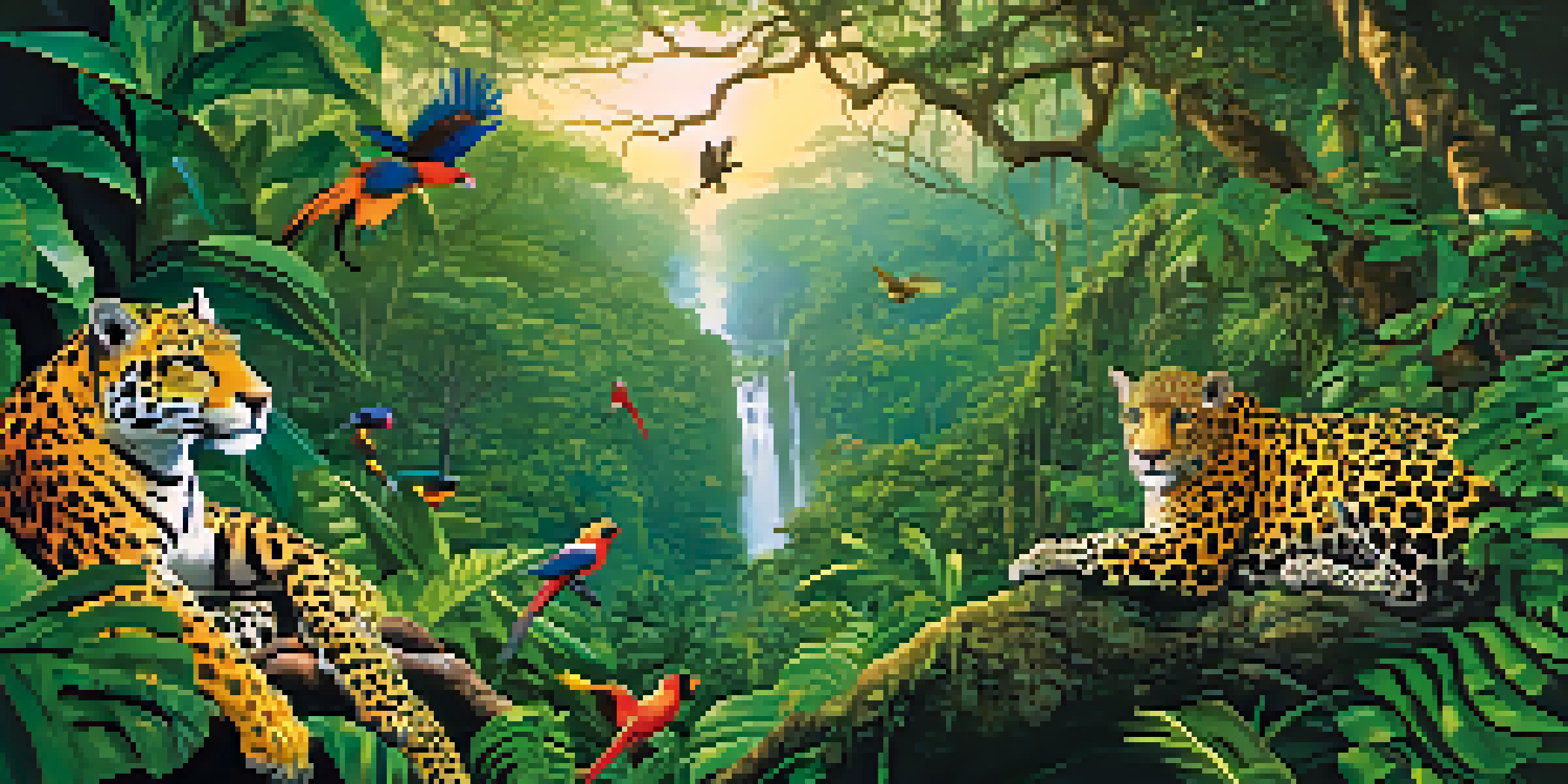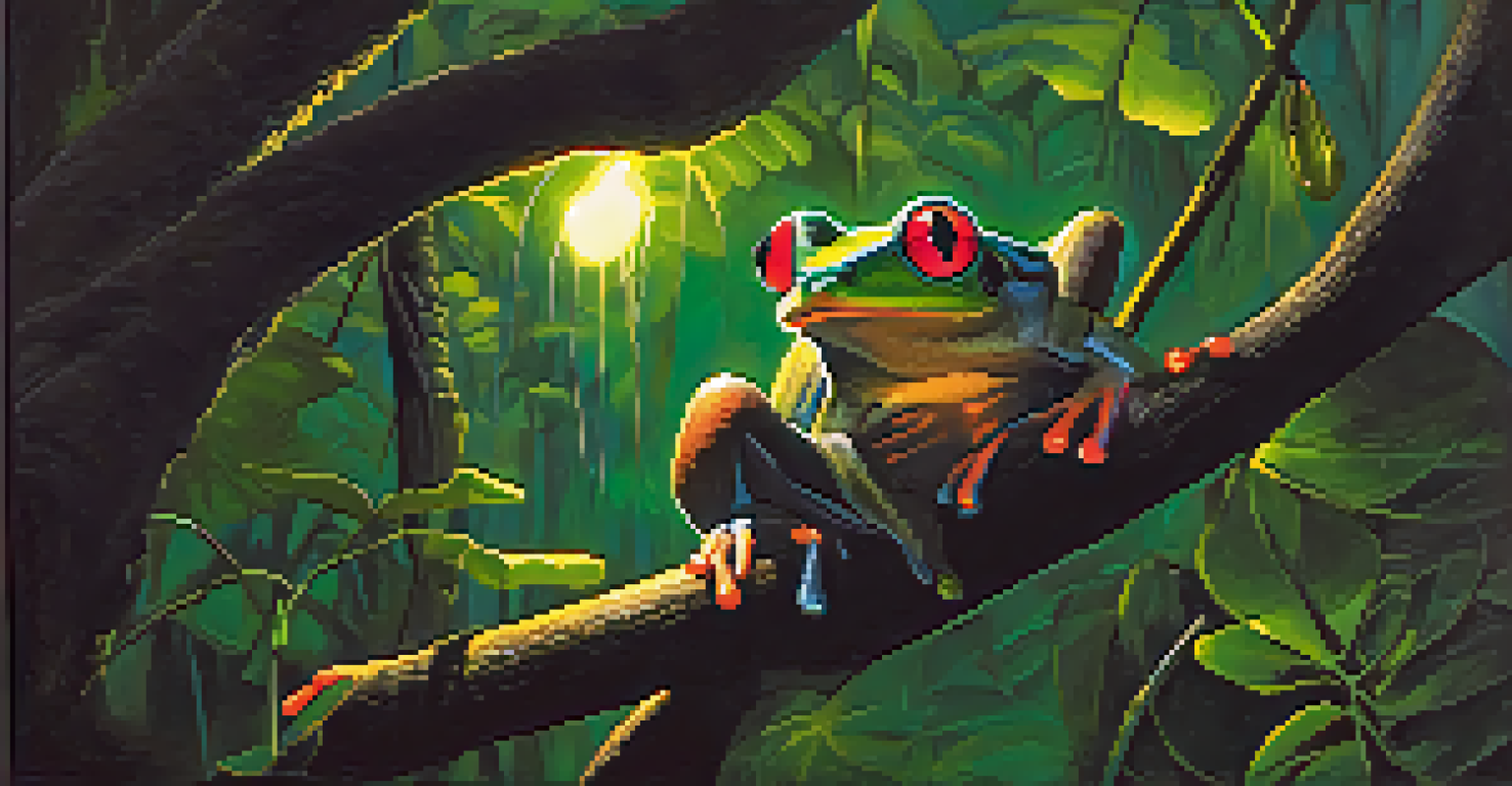Amazon Rainforest: Wildlife Watching Adventures Await

Discover the Rich Biodiversity of the Amazon Rainforest
The Amazon Rainforest is often referred to as the 'lungs of the Earth' due to its vast array of plant and animal life. Home to approximately 10% of all known species, this vibrant ecosystem is a treasure trove for wildlife enthusiasts. From the majestic jaguar to the colorful poison dart frog, every corner of the rainforest teems with unique creatures.
The clearest way into the Universe is through a forest wilderness.
What makes the Amazon so special is not just the variety of species, but also the intricate relationships between them. For instance, the symbiotic relationship between certain tree species and the insects that pollinate them shows how interconnected life is in this environment. As you explore, you'll witness nature's delicate balance firsthand, making each wildlife encounter even more meaningful.
Whether you're trekking through the dense foliage or gliding down a river, the chance to observe these incredible animals in their natural habitat is unmatched. The Amazon offers an immersive experience that leaves a lasting impression, reminding us of the importance of conservation and protecting these irreplaceable ecosystems.
Best Times to Visit for Wildlife Watching
The timing of your visit can significantly impact your wildlife watching experience in the Amazon. Generally, the dry season, which runs from June to November, is considered the best time for spotting animals. During these months, animals are more likely to congregate near water sources, making them easier to find.

However, visiting in the wet season (December to May) has its perks too. The rainforest comes alive with vibrant flora, and the sounds of wildlife are more pronounced. Many migratory bird species are also present during this time, adding to the rich tapestry of life you can witness.
Explore the Amazon's Biodiversity
The Amazon Rainforest is a vibrant ecosystem housing around 10% of all known species, showcasing intricate relationships among its diverse wildlife.
To maximize your chances of observing wildlife, consider planning your trip during the transition months of May or November. This way, you can take advantage of both the dry and wet season's offerings, ensuring diverse and exciting wildlife encounters throughout your journey.
Wildlife Watching Activities to Experience
There are numerous ways to engage in wildlife watching while exploring the Amazon. Guided jungle walks allow you to delve deeper into the rainforest, where knowledgeable guides can point out elusive species and share fascinating facts about their behaviors. These hikes provide an intimate connection with nature, as you learn to listen for the calls of various animals.
In every walk with nature, one receives far more than he seeks.
Another exciting option is canoeing or kayaking along the rivers that weave through the rainforest. This method not only offers a unique perspective but also increases your chances of encountering river-dwelling creatures like pink dolphins and caimans. The tranquility of gliding through the water enhances the experience, allowing you to soak in the beauty around you.
For those seeking an adrenaline rush, night safaris are a must-try. Venturing into the forest after dark reveals a whole new world of wildlife that is active during the night, from nocturnal mammals to colorful insects. It's an exhilarating way to experience the Amazon and witness the hidden marvels that you wouldn't see during the day.
Respecting Wildlife: Ethical Watching Practices
While the thrill of wildlife watching is undeniable, it's essential to approach it with respect and responsibility. Maintaining a safe distance from animals ensures their comfort and well-being, as getting too close can cause stress or alter their natural behaviors. Remember, you're a guest in their home, and it's crucial to tread lightly.
Additionally, avoid feeding wildlife, as this can disrupt their natural foraging habits and lead to dependency on humans. Instead, appreciate their behaviors from afar and let nature take its course. This practice not only benefits the animals but also enhances your experience, as observing them in their natural state is far more rewarding.
Best Times for Wildlife Viewing
Visiting during the dry season enhances wildlife spotting, while the wet season offers a symphony of sounds and vibrant flora to enjoy.
Educating yourself about the specific wildlife in the area you're visiting can also enhance your understanding and appreciation. Familiarizing yourself with the local fauna and their habits allows you to engage more thoughtfully with your surroundings, ensuring that your wildlife watching experience is both enjoyable and respectful.
Top Wildlife Watching Destinations in the Amazon
The Amazon Rainforest is vast, and certain areas are renowned for their wildlife watching opportunities. One such destination is the Yasuni National Park in Ecuador, celebrated for its incredible biodiversity and unique species. Here, you can find everything from giant river otters to rare bird species, making it a paradise for nature lovers.
Another fantastic location is the Tambopata National Reserve in Peru, which boasts diverse ecosystems and is home to numerous wildlife species. The reserve's clay licks, where parrots and macaws gather, offer an unforgettable spectacle that draws birdwatchers from around the globe. It's a perfect spot to witness the vibrant colors of these magnificent birds up close.
Lastly, the Pantanal region, although technically a wetlands area, is often included in Amazon wildlife tours due to its rich biodiversity. Known for its large populations of jaguars, caimans, and capybaras, the Pantanal is a haven for wildlife enthusiasts and photographers alike. Each of these destinations provides a unique experience, showcasing the incredible diversity of life that the Amazon has to offer.
Guided Tours vs. Independent Exploration
Choosing between a guided tour and independent exploration can significantly shape your wildlife watching experience in the Amazon. Guided tours often provide expert knowledge about the ecosystem, making them ideal for those who want to learn more about the species and their habitats. Plus, guides can help you navigate the complexities of the rainforest, ensuring you don’t miss out on hidden gems.
On the other hand, independent exploration offers a sense of freedom and adventure. If you're comfortable navigating on your own and have a solid understanding of wildlife watching ethics, you may find joy in crafting your own itinerary. This approach can lead to spontaneous encounters and a deeper personal connection with the environment.
Ethical Wildlife Watching Practices
Respecting wildlife by maintaining a safe distance and avoiding feeding ensures the well-being of animals and enriches your observation experience.
Ultimately, the best choice depends on your preferences and comfort level. Whether you opt for a guided tour or venture out independently, both options can lead to unforgettable wildlife experiences, allowing you to appreciate the Amazon's wonders in your own way.
Preparing for Your Amazon Wildlife Adventure
Preparation is key to ensuring a successful wildlife watching adventure in the Amazon. Start by researching the best times to visit, as well as the specific wildlife you hope to see. Packing appropriate gear, such as binoculars for birdwatching and a good camera for capturing memories, will enhance your experience and increase your chances of memorable encounters.
Clothing also plays a vital role in your comfort and safety. Lightweight, breathable fabrics that protect against mosquitos, along with waterproof boots, are essential for navigating the rainforest terrain. Additionally, don’t forget essentials like sunscreen, insect repellent, and a reusable water bottle to stay hydrated during your explorations.

Lastly, consider your physical fitness level. Wildlife watching can involve hiking through rugged terrain, so being prepared for some physical activity will enhance your enjoyment. A little preparation goes a long way, ensuring that you can fully immerse yourself in the breathtaking beauty of the Amazon Rainforest and its incredible wildlife.